Read the entire story at Healthcare Facilities Today about how preventing VFD-driven motor bearing failure in HVAC motors improves operations and cuts operating costs in hospitals.
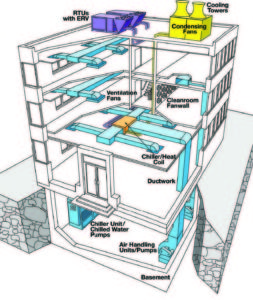 HVAC systems using VFD driven Motors in Hospitals
HVAC systems using VFD driven Motors in Hospitals
Energy Efficiency and Sustainable Operations
Maximum energy efficiency is the cornerstone of a long and growing list of building certification initiatives such as LEED, Green Globes, Zero Energy Buildings, Living Building Challenge, and Energy Star for Buildings.
Variable frequency drives (VFDs) are a crucial tool in achieving this energy efficiency. By allowing motors to run at less than full speed, VFDs match HVAC system capacity to changing heating/cooling loads, dramatically reducing energy costs. But VFDs damage the bearings of motors they control – often in as little as three months! To ensure the reliability of VFD-driven HVAC motors and lock in energy savings, proven long-term bearing protection is essential.
VFD-induced currents destroy bearings, kill motors
For years, the actual cause of VFD-induced bearing failure was often misdiagnosed. High peak voltages, fast voltage rise times, non-sinusoidal shaft currents, and parasitic capacitance associated with typical pulse-width-modulated VFDs lead to the cumulative erosion of bearings. Today, the VFD-induced electrical bearing damage is the most common cause of bearing failure in VFD-controlled AC motors.
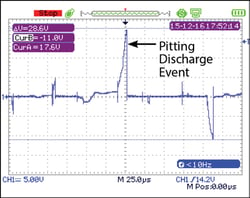 Shaft voltage showing pitting event
Shaft voltage showing pitting event
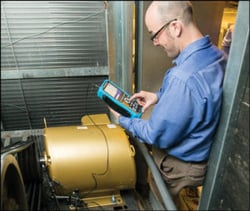 Technician taking shaft voltage measurement in a HVAC system
Technician taking shaft voltage measurement in a HVAC systemWithout mitigation, voltages repeatedly build up on the motor shaft, then discharge in short bursts along the path of least resistance, which all too often runs through the motor’s bearings. The discharge rate tends to increase with the carrier frequency.
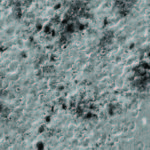 Figure 1: Bearing race with pitting damage
Figure 1: Bearing race with pitting damage
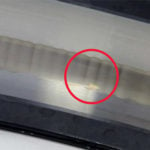 Figure 2: Bearing with fluting damage
Figure 2: Bearing with fluting damageContinued discharges result in the pitting [Figure 1] of the balls and race walls through electrical discharge machining (EDM). Concentrated pitting at regular intervals along the race wall causes washboard-like ridges called fluting [Figure 2], a source of vibration and noise that reverberates through ductwork.
By the time such damage can be heard, bearing failure is often imminent.
Shaft grounding proven effective on a rooftop unit
These rings recently proved effective in protecting motors of a packaged rooftop HVAC unit typical of those installed on commercial buildings. The unit’s VFD-controlled motor runs a belt-driven fan. Technicians from Electro Static Technology (the manufacturer of AEGIS Rings) took voltage readings — both before and after installing the ring on the motor’s shaft — using a voltage probe and a portable oscilloscope.
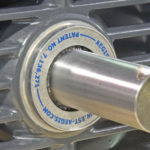 AEGIS Ring installed with Conductive Epoxy (EP2400)
AEGIS Ring installed with Conductive Epoxy (EP2400)In a continuous 60-µsec trace with the motor running at 3,600 rpm (80Hz output), discharges from the shaft were 44.8 volts peak-to-peak, high enough to cause pitting of the motor’s bearings. After installing an AEGIS Shaft Grounding Ring, follow-up readings at 3,600 rpm showed discharges of only 3.76 volts peak-to-peak, well below levels that damage bearings.
Conclusion
Operations and maintenance costs can account for 60 to 80% of a facility’s life-cycle costs. When HVAC equipment does not have to be repaired or replaced as often, this percentage drops significantly.
VFDs hold the promise of sizable energy savings, but without effective, long-term bearing protection these savings are wiped out by high maintenance costs. By diverting bearing currents safely to ground, AEGIS Rings extend motor life and ensure the reliable, long-term operation of VFD-driven systems, locking in energy savings, and making these systems sustainable.

